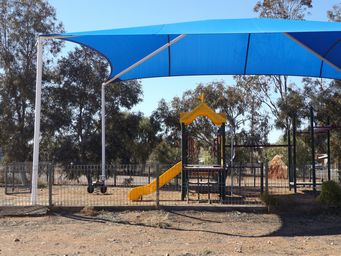New South Wales - White Cliffs
Australia So Much to See
We stayed at this well provisioned and pleasant community managed caravan park. See our review
Picture at right show as children's playground at this caravan park.
"I have been in the Outback region since the mid 1970s and have spent a considerable part of that time digging water tanks (dams)
on grazing stations in the Broken Hill and White Cliffs areas and on up to the Queensland border.
I decided to dig a house
for my wife and family on Smiths Hill here in White Cliffs. With no building code, my son Peter and I dug out five rooms. Peter lives next door with his family. We decided to join the two private residences, giving us eight bedrooms.
Why stop
there? We a detailed environmental impact study we dug and extra 22 rooms to make a total of thirty rooms, sleeping approximately
75 guests. It took somewhere between three and four years to complete by hand, using jackhammers, wheelbarrows and a mining
machine called a 'blower', more recently a hydraulic digging machine and a bobcat have been used to remove the clay (earth). Electricity was supplied from our own diesel generators; thankfully, we are now supplied with grid power coming via Victoria. This is a lot more economical and reliable than generators.
The cementing of the floors came next and the painting of
the walls. All of the walls were sprayed with Bondcrete to seal them and then painted white. The light colour enhances
the size of the place and reflects the light. Some natural coloured walls have been left as features. All up, approximately
2,500 litres of bondcrete and 4,000 of white paint have been used.
Our water supply has definitely improved through the years.
Originally, I was transporting water for the motel in my own tanker, this was a time consuming task. In 1989 I was asked to
dig a now 130,000 cubic metre tank that holds up to 21 million gallons. The tank has a catchment of sixteen square miles. The
tank holds enough water for between two and three years after allowing for nearly two metres of evaporation each year. On site
at the motel, we have five rainwater tanks, which I have designed to catch every last drop that falls (well almost).
Electrical
cables are plastered in behind the walls and run down to the floors through the borders. The lighting in the corridors stays
in all the time. Colour schemes have been chosen to add to the harmony of the place, and with a constant temperature of 22°
all year round, it is a pleasant environment to be in.
If you are wondering if I found any opals whilst digging the motel, I
didn’t, and we ask our guests to save their fossicking interests and efforts for the Opal Fields of White Cliffs."
For a $10 fee, you can wander through this unusual motel which has been cut into Smith’s Hill at your leisure. You will be provided with a map (at right) to find your way out of the maze of rooms. Each room has a ceiling vent and skylight to the exterior. To allow for plumbing there are no en suites, and bathrooms are to the front of the building outside of the carved section. Rooms are nicely finished and floors are level, smooth and carpeted.
Banner photo above shows the front of the motel. Roof vents can be seen high in the centre of this photo, with water tanks above.
Signage on site
Information panels in the Underground Motel
Tourist Brochures
Leon and Marge and their family remained at the Motel and White Cliffs until 2002 when the complex was purchased by Lateral Land. This organisation dug further along the hill, and provided what are now very comfortable staff quarters. In 2005, Richard and Jenny Beach became the owner/operators and continued to build the business as an iconic outback destination.
The business
was then purchased by Out of the Ordinary Outback in 2016.

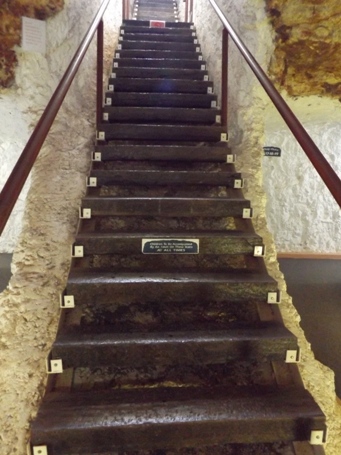

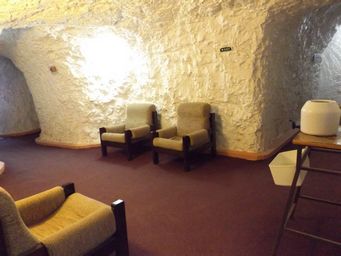
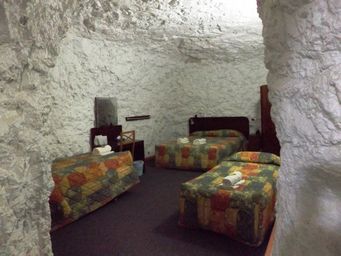
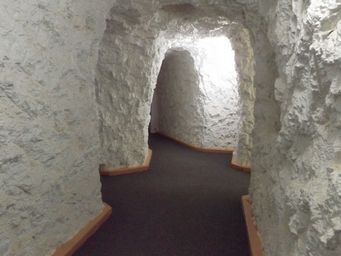



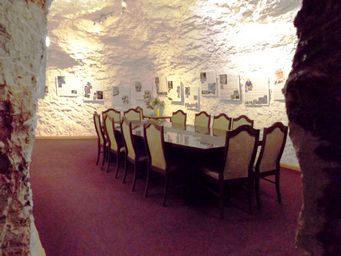
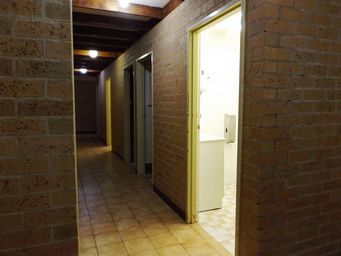

It takes a while to get your bearings in the maze of passageways (below).
